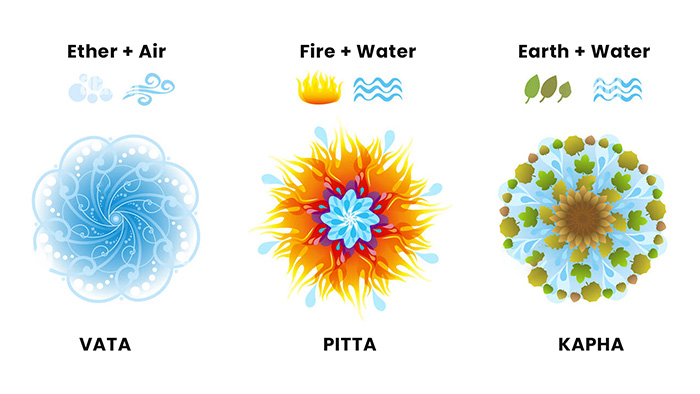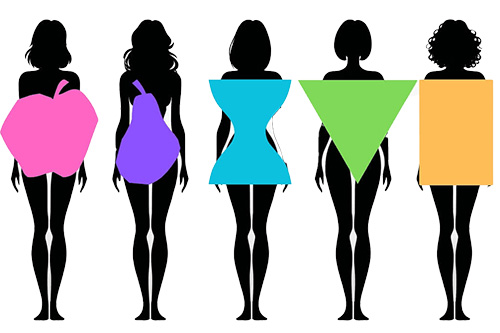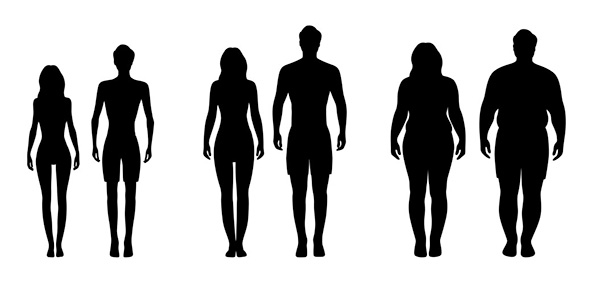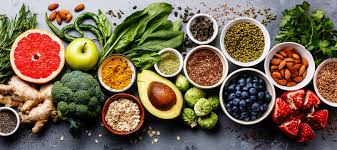If you already know your unique Type, you can purchase the right “Plan” and begin your journey toward achieving full wellbeing and fitness with an ideal body weight. If you still don’t know your Type, continue reading below and/or take the Quiz.
All Plans are designed to include all of the body type systems listed below, helping to create your unique Type.
Natural, ancient-wisdom-backed nutrition/lifestyle Plans, updated to fit the modern lifestyle.
Ati Explains What different “Types” Are
We now understand more than ever how uniquely individual each person is when it comes to following a diet. No single dietary approach works the same for two people. Ayurveda introduces the concept of the Doshas—Vata, Pitta, and Kapha—to help us understand our unique constitutions. But there’s even more to the story.
Over the past 5,000 years since Ayurveda emerged, human life has changed dramatically—our lifestyle, food sources, climate, and even our genetics have evolved. As we adapt, our bodies and biology evolve too. Through this ongoing transformation, new body types have emerged as a result of evolutionary adaptation, local environments, culinary traditions, and lifestyle factors. These modern types still carry the essence of the Doshas but reflect our current realities.
Some of these body types can be categorized as:
Type 1: Paleo / Hunter-Gatherer
Type 2: Plant-Based / Farmer
Type 3: Balanced / Herder
Each type has its own list of:
Healing foods
Neutral (everyday) foods
Weakening foods
…across all categories: grains, legumes, fruits, vegetables, meats, dairy, etc.
We also recognize the importance of other models such as:
Somatotypes (Ectomorph, Mesomorph, Endomorph) – which describe physical build and guide macronutrient needs.
Hormonal Body Typing – based on genetic fat distribution patterns (Apple, Pear, Hourglass, Inverted Triangle, etc.).
Each Dosha, body type, body shape, and somatotype has its own unique dietary requirements.
To create a truly holistic and effective nutrition plan, we must take all of these factors into account. Only then can we align diet with biology for optimal health, fitness, and well-being.
In addition, there are foundational principles of eating and nutrition that have been ignored or reversed in modern life. Our current fast-paced, convenience-driven lifestyles have turned many timeless, natural food habits upside down.
To start eating according to your unique Type, you first need to discover which types you align with. Once you know this, you can select the right nutrition/lifestyle plan and begin your journey toward reclaiming your health, vitality, and balance—the foundation of your wealth and prosperity.

In Ayurveda, the ancient Indian system of holistic health, every person is believed to have a unique balance of three vital energies known as doshas: Vata, Pitta, and Kapha. These doshas represent combinations of the five elements—earth, water, fire, air, and ether—and govern all physical and mental processes in the body. Each person typically has one or two dominant doshas that shape their body type, personality, digestion, energy levels, and emotional tendencies.
Vata is made up of air and space, and it governs movement, creativity, and communication. People with a dominant Vata dosha are often energetic, expressive, and quick thinkers but may struggle with anxiety, dry skin, or irregular digestion when out of balance. They thrive on warmth, routine, grounding foods, and calming environments.
Pitta, composed of fire and water, controls metabolism, digestion, and transformation. Pitta types tend to be strong-willed, intelligent, and goal-oriented, with a medium build and a warm body temperature. When imbalanced, they may experience inflammation, irritability, or heartburn. They do best with cooling foods, stress management, and avoiding excessive heat or intensity.
Kapha, made of earth and water, is responsible for stability, structure, and lubrication. Kapha types are often calm, compassionate, and physically strong with a tendency to gain weight easily. They benefit from stimulation, light and spicy foods, and regular physical activity to avoid sluggishness and stagnation.
Understanding your dosha can help you make more aligned choices in diet, lifestyle, and self-care, promoting greater balance and vitality.

Hunter-gatherer types are typically lean, agile, and metabolically fast, reflecting their ancestral roots in high-activity, survival-based lifestyles. Their bodies are built for quick bursts of energy, and adaptability, often resulting in naturally lower body fat and smaller bone structure. These individuals usually have high energy levels but can burn out quickly if overstimulated or undernourished. They often thrive on paleo type diet, meals with higher protein and healthy fats, plus variety of fresh fruits & vegetables. They may feel sluggish or heavy with too many carbohydrates, especially refined processed ones. Because they’re wired for movement and variety, they benefit most from diverse, functional workouts—like walking, mobility work, or interval training—and do best with calming practices like yoga or mindfulness to counterbalance their naturally wired nervous systems.

Farmer types have sturdier, more solid builds and tend to gain weight more easily, especially around the midsection, due to a slower, more efficient metabolism. Their ancestry links back to agrarian communities where food was more consistent but required long hours of physical labor—so their bodies are designed to store energy and use it slowly. They often have a calm, steady temperament and do well with routines, structure, and discipline. However, they may struggle with sluggishness, cravings, or insulin resistance if their diet is too high in carbohydrates or if activity levels drop. Farmer types thrive on vegan/vegetarian type diet, meals with higher carbs, higher fiber, beans/legumes & variety of fresh vegetables. Some protein can be included in their diet. Farmer types tend to have a more sensitive stress response, particularly involving cortisol, the body’s primary stress hormone. So they can be more prone to chronic stress, anxiety, or adrenal fatigue if over-stimulated. They do well with calming, steady-state exercises like Yoga – excellent for reducing cortisol and supporting recovery, Pilates, Tai Chi or Qigong – supports mind-body balance and emotional regulation, walking or hiking – low-impact and great for cardiovascular health, cycling or swimming (moderate pace) – Keeps the heart healthy without over-stressing the system

Herder types, also known as nomadic or pastoral types, typically have medium to broad builds with a strong, resilient constitution. Their ancestors lived in environments where survival depended on mobility, harsh climates, and a diet rich in animal products—particularly red meat (not beef though) and dairy product. As a result, herder types often tolerate high-protein (nomadic type herd in particular), high-fat diets well and may even thrive on moderate dairy intake, unlike other types. They are the balanced type, so their diet should consist of a good balance of carbohydrates, beans/legumes, animal protein, fat & dairy products. They usually have stable energy, moderate appetites, and a balanced metabolism, but they can become sluggish or gain weight if overly sedentary or if their diet becomes too carb-heavy. This type benefits from a balanced kind of workout, a mix of strength training and endurance-based movement (like cycling or long walks), along with steady, nutrient-dense meals that emphasize protein and healthy fats. Consistency in routine—without too much rigidity—helps them feel and function at their best.

Body shapes describe how your body naturally distributes fat and muscle. While genetics play a key role, hormones like estrogen, cortisol, insulin, and testosterone strongly influence where fat is stored, how easily it’s gained or lost, and how your body responds to diet and exercise. Understanding your shape is helpful when it comes to tailor your approach to fitness, nutrition, and hormone balance.
The 5 Major Body Shapes & Their Hormonal Links: (From Left to Right)
Apple (Android)
Fat storage: Mainly around the abdomen and upper body
Hormonal link: Often tied to cortisol (stress hormone) or insulin resistance
Risks: Higher visceral fat, linked to heart and metabolic issues
Pear (Gynoid)
Fat storage: Around the hips, thighs, and buttocks
Hormonal link: Linked to estrogen dominance
Tends to: Store subcutaneous fat, which is less risky but harder to lose
Hourglass
Fat storage: Evenly between upper and lower body with a defined waist
Hormonal balance: More hormonally balanced, but may gain weight proportionally
Strength: Responsive to exercise and dietary changes
Inverted Triangle
Fat storage: Broad shoulders/chest, slimmer hips and legs
Hormonal link: Often testosterone or growth hormone influence
Tends to: Build upper body muscle easily; may store fat on back or midsection
Rectangle
Fat storage: Minimal curves, fat stored evenly with little waist definition
Hormonal link: Often a lower estrogen/testosterone balance
Tends to: Have a faster metabolism, may struggle to gain curves or muscle

Somatotypes are a classification system that describes body types based on natural physique, muscle and fat distribution, and metabolic tendencies. The somatotype system divides bodies into three main categories: Ectomorph, Mesomorph, and Endomorph. While most people are a blend of two or more types, one is usually dominant.
(From Right to Left):
Ectomorph
Traits: Lean, narrow frame, fast metabolism
Tends to: Have trouble gaining weight or muscle
Needs: Higher calorie intake, strength training, stress recovery
Mesomorph
Traits: Naturally muscular, athletic build, efficient metabolism
Tends to: Gain muscle easily, moderate fat gain
Needs: Balanced training (strength + cardio) and moderate nutrition
Endomorph
Traits: Softer, rounder body, slower metabolism
Tends to: Store fat easily, especially around hips, thighs, or abdomen
Needs: Focus on fat-burning workouts, clean eating, and blood sugar balance

Biochemical types refer to the idea that each person has a unique internal chemistry that affects how their body processes nutrients, hormones, and neurotransmitters. This concept is rooted in biochemical individuality—a theory, which suggests that no two people have identical nutritional needs, even if they appear similar on the outside.
Key Elements of Biochemical Typing:
Metabolic Rate & Dominance:
Some people are fast oxidizers (burn food quickly and feel best with more fats and protein), which is very similar to Type 1 Hunter-gatherer.
Others are slow oxidizers (process food more slowly and may do better with more complex carbs), which is very similar to Typ 2 Farmer.
Autonomic Nervous System Balance:
People may be sympathetic dominant (more “fight or flight,” fast-reacting, higher stress) or parasympathetic dominant (more relaxed, slower metabolism, needs stimulation). This influences how your body responds to stress, food, and exercise
Neurotransmitter Profile:
Types of dopamine, serotonin, GABA, and acetylcholine can affect mood, cravings, and behavior. For example, a dopamine-deficient person may seek stimulation (like sugar or caffeine), while someone serotonin-deficient may struggle with mood stability.
There isn’t one fixed system to determine how many types are there, but in functional and nutritional medicine, biochemical typing is usually based on a combination of systems. Depending on the approach, you might see anywhere from 3 to 9 biochemical types. The most well-known frameworks include:
1. Metabolic Typing (3 Main Types):
This system focuses on how your body metabolizes food.
Fast Oxidizer – Burns food quickly; needs more fat and protein
Slow Oxidizer – Burns food slowly; does better with more carbs
Mixed Oxidizer – A balance of both; needs a mixed macro ratio
2. Autonomic Nervous System Typing (3 Main Types):
This theory looks at whether you’re more dominant in the sympathetic (“fight or flight”) or parasympathetic (“rest and digest”) system.
Sympathetic Dominant – More alert, wired, stress-reactive
Parasympathetic Dominant – Calmer, slower metabolism, can feel sluggish
Balanced Type – Even activity between both branches
3. Neurotransmitter Typing (Up to 4 Types):
Based on neurotransmitter dominance or deficiency, affecting mood, cravings, and mental performance.
Dopamine Type – Driven, focused, may crave stimulation
Serotonin Type – Calm, but may struggle with low mood or motivation
GABA Type – Needs emotional stability and relaxation
Acetylcholine Type – Mental clarity, fast learner, may burn out easily
We use cookies to improve your experience on our site. By using our site, you consent to cookies.
Websites store cookies to enhance functionality and personalise your experience. You can manage your preferences, but blocking some cookies may impact site performance and services.
Essential cookies enable basic functions and are necessary for the proper function of the website.
You can find more information in our Terms of Use and Privacy Policy.